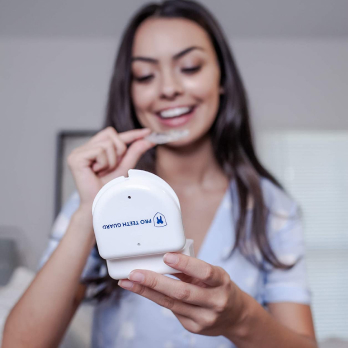Bruxism Face Change
4th Jul 2021

Bruxism, a condition characterized by jaw clenching and teeth grinding, can lead to many unwanted side effects, such as sore jaw or worn enamel. Surprisingly, another common side effect of clenching and grinding is bruxism face change. While this side effect might not cause physical pain, it can be alarming when you notice that the shape of your face has changed.
One of the most surprising outcomes of not getting treatment for bruxism is change to the face shape, ranging from minor to major aesthetic differences. Below, learn how bruxism changes your face shape and what you can do to reverse the changes.

Can Teeth Grinding Change Face Shape?
In short, yes, bruxism can change the shape of your face. The condition involves jaw clenching and overuse of the facial muscles, thus, it can alter the shape of your face.
Typically, consistent overuse of these jaw muscles creates a square face shape, a swollen appearance, and a strong jawline. Many people refer to this as a more masculine face shape. When you clench or grind, you can also prematurely age your face (Almukhtar & Fabi, 2019).
Related Articles:
How Does Bruxism Change Your Face Shape?
Bruxism changes your face shape because when you clench or grind your teeth, you are overusing your jaw muscles. The mandible is the strongest bone of the face and forms the lower jaw and temporomandibular joint. The muscles which move the mandible up and down are the masseter muscles. These muscles are the “master muscles” of the upper and lower jaw. They are responsible for chewing and, subsequently, grinding.
When these muscles are overused, it is referred to as masseter hypertrophy, or enlargement of the masseter muscles. This enlargement causes the lower portion of your face to appear wider or more square. Over time, your face can even change due to bone loss from repeated grinding. This bone loss can shorten your lower face (Peter DMD).
It makes sense that overuse of these muscles would lead to a change in appearance just as an overuse of a muscle in any other part of the body would change the appearance as well. For example, if you spend a lot of time exercising and lifting weights with your arm muscles, the appearance of your arms will change.
Of course, when you change your appearance by deliberately working a muscle group in your body, you get a desired change. The change of appearance in your face as a result of bruxism is not typically a welcomed change. Learn below how to reverse these unwanted bruxism facial changes.

Can You Reverse the Effects of Bruxism on Your Face?
Thankfully, it is possible to reverse the effects of bruxism face change.
If you successfully treat your bruxism and stop grinding or clenching your teeth, your face will return to its original shape. Treating bruxism will also prevent worsening of other symptoms, which may include facial pain, earaches, headaches, jaw pain, jaw soreness, and tooth wear. You might also experience orofacial pain, which is pain in the face, mouth, and jaw region (Badel et al 2019).
There are quite a few treatment options for bruxism. Common and effective treatment methods include:
- Night guards or splints for sleep bruxism/TMJ
- Injectable botox
- Biofeedback headband for bruxism
- Relaxation techniques
- Vitamins and supplements for TMJ and bruxism (Magnesium, Vitamin B, Calcium)
- Reduce alcohol and caffeine consumption
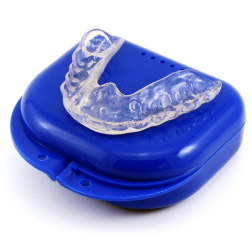
- Most Popular
- Hard Outside, Soft Inside
- 2MM Thick
- Moderate / Heavy
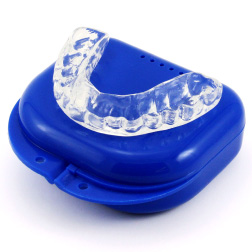
- Most Durable
- Hard Materials
- 1.5MM Thick
- Heavy / Severe
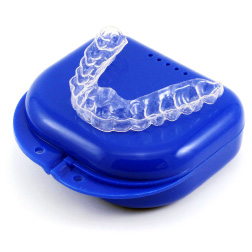
- For Day Time Use
- Thin, Barely Visible
- 1MM Thick
- Light / Moderate
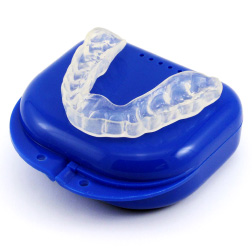
- For Clenching
- Flexible & Soft
- 1.5MM Thick
- Light / Moderate
You can also try to reduce the effects of bruxism by avoiding things or treating conditions that irritate the temporomandibular joint or that exacerbate bruxing. These include chewing gum, chewy foods, certain antidepressants, recreational drugs, and sleep disorders such as sleep apnea.
Even with treatment, some people find they cannot stop clenching or grinding their teeth at night. Because it’s an involuntary and unconscious action, it can be very difficult to stop. If your face shape has changed and you have not been able to stop bruxing, a dermatologist may be able to help.
In addition to botox, a dermatologist can use fillers and lasers to obtain your desired face shape. “Combining botulinum toxin, fillers, and laser resurfacing has been shown to provide better, longer-lasting results when used in combination,” according to an article published in The Journal of Clinical and Aesthetic Dermatology. This combined treatment is particularly effective for treating premature aging due to bruxism.
Related Articles:
Reducing the Effects of Bruxism Face Change
If you have bruxism and have noticed a change in your face shape, you’re not imagining it. Due to overuse of the jaw muscles, your face might become more square or swollen. You might also get a more pronounced jawline and notice premature aging.
Various treatment methods can help reduce jaw movements and protect your teeth from the effects of bruxism. One of the most common treatment methods is a mouth guard, which is typically worn at night.
Pro Teeth Guard offers custom-fit mouthguards online for an affordable price. Our oral appliances are made in a professional dental lab after you take an impression of your teeth from the comfort of your own home.
References:
- Aguilera, S. B., Brown, L., & Perico, V. A. (2017). Aesthetic Treatment of Bruxism. The Journal of clinical and aesthetic dermatology, 10(5), 49–55. https://www.ncbi.nlm.nih.gov/pmc/articles/PMC54794...
- .Almukhtar, R. M., & Fabi, S. G. (2019). The Masseter Muscle and Its Role in Facial Contouring, Aging, and Quality of Life: A Literature Review. Plastic and reconstructive surgery. https://journals.lww.com/plasreconsurg/Abstract/20...
- Badel, T., Zadravec, D., Bašić Kes, V., Smoljan, M., Kocijan Lovko, S., Zavoreo, I., Krapac, L., & Anić Milošević, S. (2019). OROFACIAL PAIN - DIAGNOSTIC AND THERAPEUTIC CHALLENGES.https://hrcak.srce.hr/clanak/327121

- Most Popular
- Hard Outside, Soft Inside
- 2MM Thick
- Moderate / Heavy

- Most Durable
- Hard Materials
- 1.5MM Thick
- Heavy / Severe

- For Day Time Use
- Thin, Barely Visible
- 1MM Thick
- Light / Moderate

- For Clenching
- Flexible & Soft
- 1.5MM Thick
- Light / Moderate

